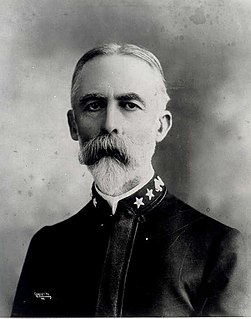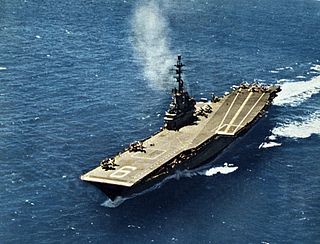Four ships in the United States Navy have been named USS Sampson for Rear Admiral William T. Sampson (1840–1902), known for his victory in the Battle of Santiago de Cuba during the Spanish–American War.

The United States Navy (USN) is the naval warfare service branch of the United States Armed Forces and one of the seven uniformed services of the United States. It is the largest and most capable navy in the world and it has been estimated that in terms of tonnage of its active battle fleet alone, it is larger than the next 13 navies combined, which includes 11 U.S. allies or partner nations. with the highest combined battle fleet tonnage and the world's largest aircraft carrier fleet, with eleven in service, and two new carriers under construction. With 319,421 personnel on active duty and 99,616 in the Ready Reserve, the Navy is the third largest of the service branches. It has 282 deployable combat vessels and more than 3,700 operational aircraft as of March 2018, making it the second-largest air force in the world, after the United States Air Force.

William Thomas Sampson was a United States Navy rear admiral known for his victory in the Battle of Santiago de Cuba during the Spanish–American War.

The Battle of Santiago de Cuba was a naval battle that occurred on July 3, 1898, in which the United States Navy decisively defeated Spanish forces, sealing American victory in the Spanish–American War and achieving nominal independence for Cuba from Spanish rule.
- USS Sampson (DD-63) was the lead ship of her class of destroyers, commissioned in 1916, served in World War I and decommissioned in 1921.
- USS Sampson (DD-394) was a Somers-class destroyer, commissioned in 1938, served in World War II, and decommissioned in 1946.
- USS Sampson (DDG-10) was a Charles F. Adams-class guided missile destroyer, commissioned in 1961 and decommissioned in 1991.
- USS Sampson (DDG-102) is an Arleigh Burke-class guided missile destroyer. She was commissioned in 2007.

USS Sampson (DD-63) was the lead ship of her class of destroyers of the United States Navy. She was the first Navy ship named for Admiral William T. Sampson (1840–1902).

The lead ship, name ship, or class leader is the first of a series or class of ships all constructed according to the same general design. The term is applicable to military ships and larger civilian craft.

The Sampson-class destroyers served in the United States Navy during World War I. Commissioned in 1916 and 1917, the class was a modification of the O'Brien and Tucker classes, with the number of 21-inch (533 mm) torpedo tubes increased from four twin-mounts to four triple-mounts. The Sampsons were the final six ships of the 26 "thousand tonner" destroyers. They were the largest and most heavily armed of the "thousand tonners", and the subsequent "flush deck" classes differed mainly in hull design and the engineering plant.
| This article includes a list of ships with the same or similar names. If an internal link for a specific ship led you here, you may wish to change the link to point directly to the intended ship article, if one exists. |





